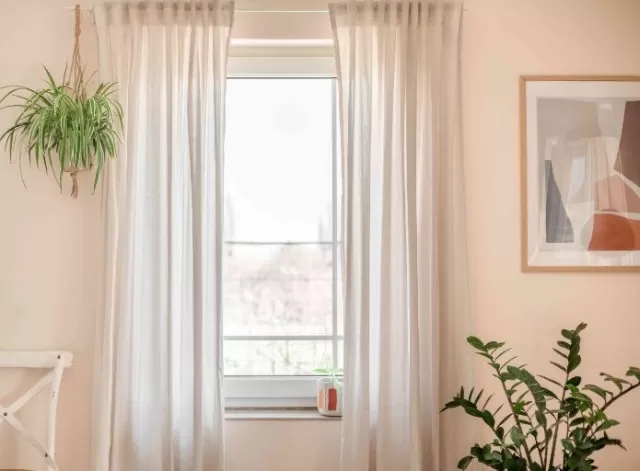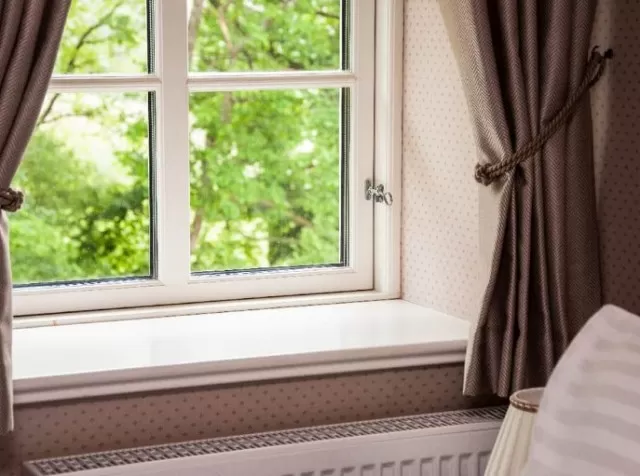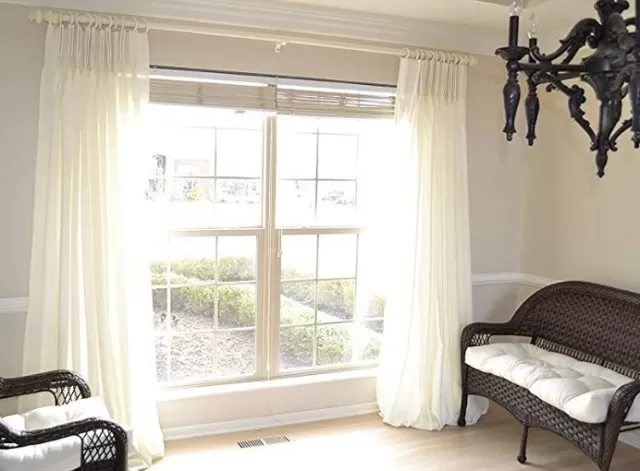Choosing Curtain Length for Your Windows: A Practical Guide. Selecting the right curtain length is crucial for enhancing the overall aesthetics of a room. According to Kati Curtis, an interior designer from Kati Curtis Design, one fundamental rule to follow is that “your curtains should graze the floor.”
So, how can you accomplish this? Properly measuring your window and ordering the correct fabric are key factors in creating a polished and harmonious space. Let’s explore the essential steps to achieve the ideal curtain length.
Mastering Curtain Measurements: How to Measure Your Window

To ensure that your curtains fit perfectly and complement your space, it is essential to measure your window accurately.
Follow these steps to measure your window for curtains:.
Gather the necessary tools: Prepare a measuring tape, a notepad, and a pen to record your measurements.
Measure the width: Start by measuring the width of the window.
Begin from one inside edge of the window frame and measure to the other inside edge. Take note of this measurement.
Determine the rod width: If you already have a curtain rod, decide how much space you want the curtains to cover on each side of the window.
Typically, adding an extra 4 to 8 inches (10 to 20 cm) on each side of the window frame creates a pleasing look. Add this additional width to your window width measurement.
Measure the height: Measure the height from the top edge of the window frame to the desired endpoint.
Depending on your preference, curtains can hang just below the windowsill, reach the floor, or even puddle gracefully on the floor. Note down this measurement.
Consider additional height: If you prefer curtains that hang above the window frame or higher on the wall, measure from that desired point down to the endpoint you previously determined.
This will give you the total height measurement.
Double-check your measurements: Before purchasing or ordering curtains, double-check all your measurements to ensure accuracy.
The Rule of 10s: Curtain Measurement Tips for Perfect Fit
When it comes to measuring your curtains, there’s one key number to remember: 10.
Following this guideline will help you achieve the ideal fit. According to Kati Curtis, keeping 10 inches above the trim and 10 inches wider than your window on each side is generally the best approach. However, if your space doesn’t allow for that much width, halving it to 4 or 5 inches can work as well. For rooms with higher ceilings, curtain placement can be determined based on the height of the room. The curtain rod or hardware should be positioned at the ceiling, just below the crown molding, or 12 to 24 inches above the window trim, as suggested by Curtis.
The Importance of Field Measurement: Ensuring Accurate Curtain Length

When measuring curtains, Kati Curtis emphasizes the significance of field measurement.
Taking multiple measurements from the planned top of your curtain to the floor is crucial. According to Curtis, “Most homes have floors and ceilings that aren’t anywhere close to being level, so it’s important to take multiple measurements along the width of your curtains so that they can be fabricated to adjust for this.
“.
Field measuring allows for accurate adjustments to be made during the fabrication process, ensuring that your curtains are tailored to fit the unique characteristics of your space.
By taking multiple measurements along the width, you can account for any unevenness in the floors or ceilings, resulting in a polished and visually pleasing curtain presentation.
Choosing the Right Standard Length Curtains
When purchasing standard length curtains, it’s essential to consider the available options and select the most suitable length for your space.
Here’s a helpful guide to buying standard length curtains:.
Length options: Standard curtains typically come in three lengths: 84 inches, 96 inches, or 108 inches.
Avoid 84-inch curtains: In most cases, it’s best to steer clear of the 84-inch standard curtains unless you have very low ceilings.
They often appear awkward and may not complement the room well.
Opt for 96 or 108-inch curtains: The 96-inch and 108-inch lengths work well in a wider range of typical spaces.
Round to the closest length based on your measurements.
Choose longer over shorter: When in doubt, it’s better to select longer curtains rather than ones that are too short.
Longer curtains provide better coverage and create a more visually appealing look.
Don’t fake it: Even if your curtains will be placed behind furniture, it’s advisable not to try to fake a shorter length.
Curtains that are too short lack the necessary weight and presence, compromising the overall aesthetic.
The Advantages of Custom Curtains: Elevating Your Space

When it comes to selecting curtains for your space, Kati Curtis recommends considering custom curtains over standard lengths.
While standard curtains may work in certain scenarios, Curtis encourages opting for custom curtains in every situation. Here are the advantages of choosing custom curtains:.
Tailored to your space: Custom curtains are designed specifically for your windows, ensuring a perfect fit and complementing the unique dimensions and characteristics of your room.
Endless design options: With custom curtains, you have a wide range of design choices, including various fabrics, patterns, colors, and textures.
This allows you to create a truly personalized and cohesive look that aligns with your style and decor.
Precise measurements: Custom curtains are made based on accurate measurements taken for your windows.
This eliminates any concerns about length, ensuring the curtains hang flawlessly and enhance the overall aesthetics of the space.
Enhanced quality and craftsmanship: Custom curtains are typically crafted with meticulous attention to detail, using high-quality materials and superior craftsmanship.
This results in curtains that not only look stunning but also have a longer lifespan.
Personalized style and function: Custom curtains provide the opportunity to customize various features, such as blackout lining for light control, thermal lining for energy efficiency, or additional trims and embellishments to add unique touches.
Collaborating with a Designer for Perfect Curtain Solutions

Working with a designer when selecting curtains can offer numerous benefits and ensure exceptional results.
Here’s why collaborating with a designer is valuable:.
Expert guidance on length and fit: A designer can accurately measure your windows, taking into account any unevenness in the floor or ceiling.
This ensures that your curtains are precisely tailored to the space, even if it’s not perfectly level.
Customized print and pattern selection: Designers have an eye for choosing prints and patterns that harmonize with the size of your curtains and the overall aesthetic of your space.
They can guide you in selecting the most suitable options that complement your existing decor.
Professional finishing touches: A designer’s expertise ensures that the finished product is polished and visually stunning.
They have the knowledge and skills to create custom details and add unique elements that elevate the overall look of your curtains.
Avoid costly mistakes: Window treatments are a significant investment for your home.
By working with a designer, you can avoid potential mistakes and regrets, ensuring that your curtain choices align with your vision and goals.
*The information is for reference only.